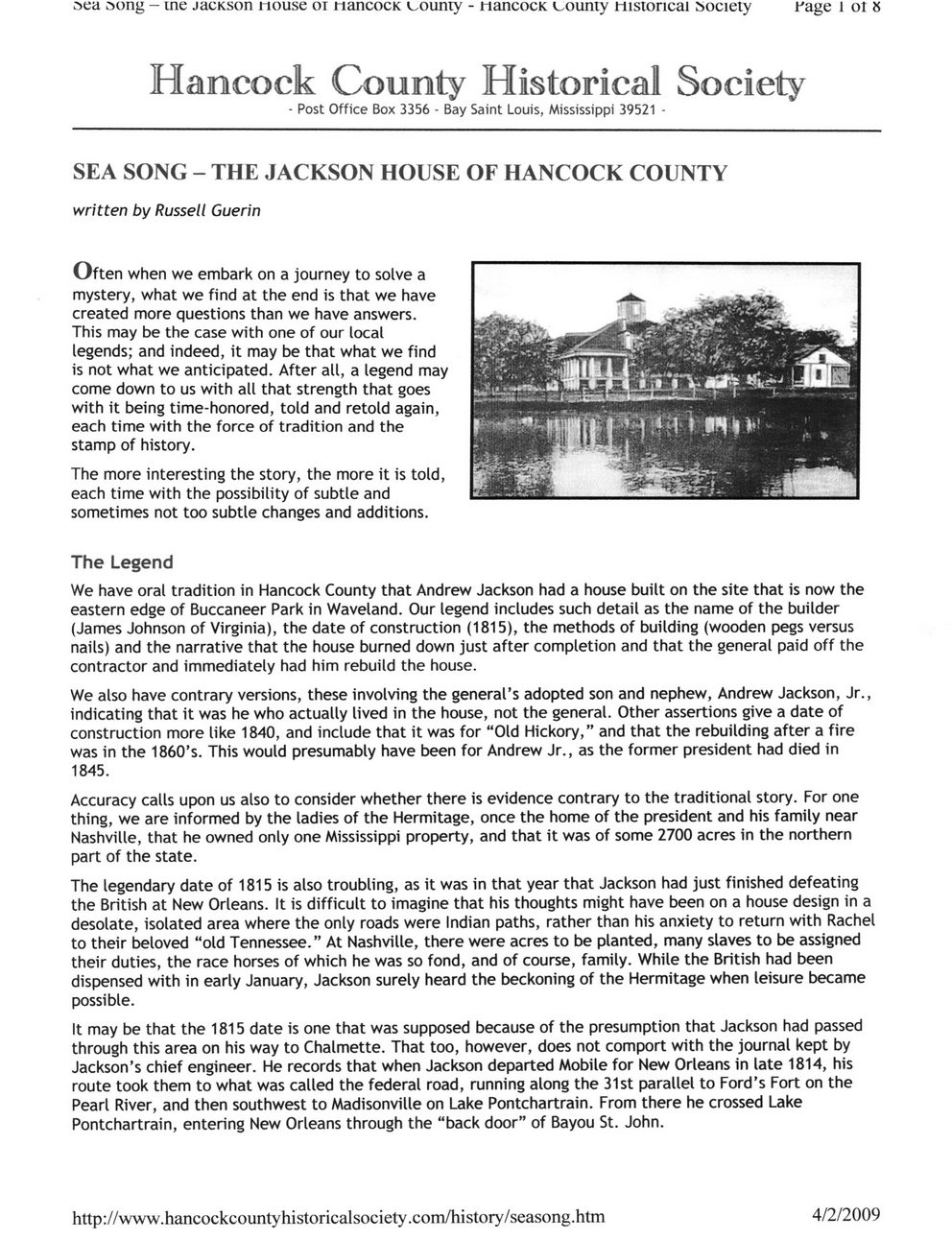This text was obtained via automated optical character recognition.
It has not been edited and may therefore contain several errors.
sea song - xne jacKson nouse 01 tiancocK county - tiancocK L.ounty Historical society Page l ot 8 Hancock County Historical Society - Post Office Box 3356 - Bay Saint Louis, Mississippi 39521 - SEA SONG - THE JACKSON HOUSE OF HANCOCK COUNTY written by Russell Guerin Often when we embark on a journey to solve a mystery, what we find at the end is that we have created more questions than we have answers. This may be the case with one of our local legends; and indeed, it may be that what we find is not what we anticipated. After all, a legend may come down to us with all that strength that goes with it being time-honored, told and retold again, each time with the force of tradition and the stamp of history. The more interesting the story, the more it is told, each time with the possibility of subtle and sometimes not too subtle changes and additions. The Legend We have oral tradition in Hancock County that Andrew Jackson had a house built on the site that is now the eastern edge of Buccaneer Park in Waveland. Our legend includes such detail as the name of the builder (James Johnson of Virginia), the date of construction (1815), the methods of building (wooden pegs versus nails) and the narrative that the house burned down just after completion and that the general paid off the contractor and immediately had him rebuild the house. We also have contrary versions, these involving the general?s adopted son and nephew, Andrew Jackson, Jr., indicating that it was he who actually lived in the house, not the general. Other assertions give a date of construction more like 1840, and include that it was for ?Old Hickory,? and that the rebuilding after a fire was in the 1860?s. This would presumably have been for Andrew Jr., as the former president had died in 1845. Accuracy calls upon us also to consider whether there is evidence contrary to the traditional story. For one thing, we are informed by the ladies of the Hermitage, once the home of the president and his family near Nashville, that he owned only one Mississippi property, and that it was of some 2700 acres in the northern part of the state. The legendary date of 1815 is also troubling, as it was in that year that Jackson had just finished defeating the British at New Orleans. It is difficult to imagine that his thoughts might have been on a house design in a desolate, isolated area where the only roads were Indian paths, rather than his anxiety to return with Rachel to their beloved ?old Tennessee.? At Nashville, there were acres to be planted, many slaves to be assigned their duties, the race horses of which he was so fond, and of course, family. While the British had been dispensed with in early January, Jackson surely heard the beckoning of the Hermitage when leisure became possible. It may be that the 1815 date is one that was supposed because of the presumption that Jackson had passed through this area on his way to Chalmette. That too, however, does not comport with the journal kept by Jackson?s chief engineer. He records that when Jackson departed Mobile for New Orleans in late 1814, his route took them to what was called the federal road, running along the 31st parallel to Ford?s Fort on the Pearl River, and then southwest to Madisonvilte on Lake Pontchartrain. From there he crossed Lake Pontchartrain, entering New Orleans through the ?back door? of Bayou St. John. http://www.hancockcountyhistoricalsociety.com/history/seasong.htm 4/2/2009

Bookter Alexander-015